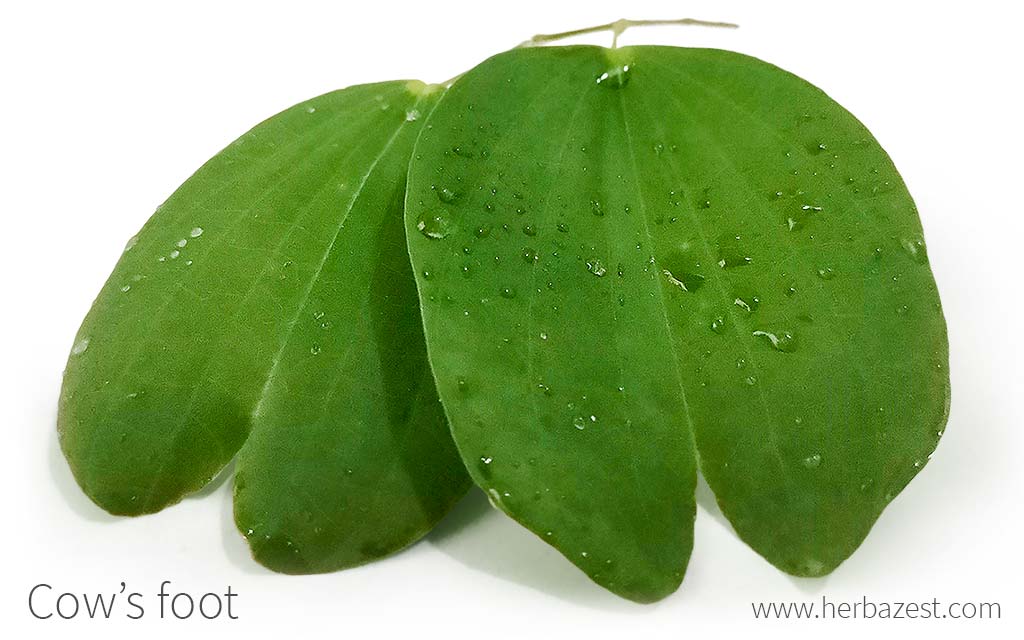Cow's foot, also known as cow's hoof, Brazilian orchid tree, white butterfly orchid tree, and Brazilian butterfly tree, among other names, is a tree native to Asia and South America. It has long been used in traditional medicine, and recent scientific research has validated some of its purported health benefits, particularly for managing hyperglycemia and type 2 diabetes.
Cow's Foot Medicinal Properties
Benefits of Cow's Foot
The cow's foot plant, also known as the Brazilian orchid tree and cow's hoof, among other names, has a long history of use in folk medicine in the South American regions where it naturally grows. Scientific research has validated some of these traditional applications, particularly its use in the treatment of type 2 diabetes. The most well-researched health benefits of cow's foot include:
Improving insulin resistance. Active compounds in cow's foot can influence glucose metabolism, aiding in the treatment of hyperglycemia and type 2 diabetes.
Reducing inflammation and pain. The antioxidant and anti-inflammatory properties of cow's foot make it effective for relieving pain associated with inflammatory conditions, such as rheumatism.
Due to its diuretic and antimicrobial properties, cow's foot has been traditionally used for reducing uric acid levels and treating gynecological problems.
How It Works
The benefits of cow's foot are attributed to its high levels of flavonoids, along with terpenoids, alkaloids, steroids, phenolic acids, and fatty acids.
It is thought that high concentrations of a flavonoid called kaempferitrin play an important role in the hypoglycemic effects of cow's foot.1 Studies have shown that cow's foot is effective as an adjuvant treatment for glycemic control in patients with type 2 diabetes.2
Cow's foot has also been shown to have anti-inflammatory and antinociceptive properties, reducing pain signals through neuronal inhibition.3
The antimicrobial properties of cow's foot leaves have been shown to inhibit the proliferation of Candida albicans.4
Other herbs with hypoglycemic properties are cinnamon, stevia, and soursop.
Side Effects
Preliminary studies suggest that using cow's foot leaves to regulate glucose levels has no known side effects; however, further research is necessary to confirm the safety of this herb.5
Cautions
People with hyperglycemia and diabetes taking prescribed medications should be aware that cow's foot can further lower blood sugar levels, which can lead to hypoglycemia. This herb should be taken under medical supervision.
- Medicinal action Anti-inflammatory, Hypoglycemic
- Key constituents Flavonoids, terpenoids, alkaloids, steroids, phenolic acids, and fatty acids
- Ways to use Capsules, Decoctions, Hot infusions/tisanes, Liquid extracts, Tincture
- Medicinal rating (2) Minorly useful plant
- Safety ranking Safety undetermined

How to Consume Cow's Foot
The cow's foot herb has traditionally been used primarily for medicinal purposes.
Natural Forms
Infusion. This is the preferred way of consuming this herb. A warm tea made from fresh or dried cow's foot leaves can be taken to help stabilize blood sugar levels.
Decoction. This is a more concentrated preparation that involves boiling cow's foot leaves for a few minutes before drinking.
Herbal Remedies & Supplements
Liquid extract. This medicinal form of cow's foot leaf requires just a few drops diluted in a glass of water to reap its hypoglycemic benefits.
Tincture. This herbal preparation is made by macerating cow's foot leaves in a neutral alcohol base. Like the liquid extract, a few drops of tincture should be diluted in water before ingestion.
Capsules. Cow's foot leaf capsules are a popular supplement, as they provide practical, standardized doses for people seeking to control their blood sugar levels naturally.
- Edible parts Leaves
- Taste Earthy, Mild

Growing
The cow's foot tree, also known as the Brazilian orchid tree or Brazilian butterfly tree, thrives in the tropical climates of South America and Asia. However, it can be cultivated in warm regions as long as its basic requirements for water, soil, and temperature are met. This versatile tree can be a beautiful addition to a garden, backyard, or shrubbery entrance.
Growing Guidelines
The cow's foot tree can be propagated by seeds, suckers, layering, or cuttings.
It is highly tolerant of different types of soil as long as they are well-drained. Suitable substrates include clay, sandy, loamy, acidic, and slightly alkaline soils.
The plant requires full sun exposure and a moderate amount of water, though it is highly tolerant of dry spells.
Like other orchid trees, cow's foot benefits from early pruning and branch training to prevent spreading and create a shape that complements its environment.
This type of orchid tree is highly resistant to pests and diseases but may occasionally be attacked by aphids.
Orchid-like blooms appear abundantly from spring through summer, followed by flat, dark brown seed pods.
- Life cycle Perennial
- Harvested parts Leaves
- Light requirements Full sun, Partial shade
- Soil Well-drained
- Soil pH 4.5 – 5.0 (Very strongly acidic), 5.1 – 5.5 (Strongly acidic), 5.6 – 6.0 (Moderately acidic), 6.1 – 6.5 (Slightly acidic), 6.6 – 7.3 (Neutral), 7.4 – 7.8 (Slightly alkaline)
- Growing habitat Tropical regions, Warm climates
- USDA Plant Hardiness Zones 10a, 10b, 11a, 11b
- Propagation techniques Cuttings, Layering
- Potential insect pests Aphids
Additional Information
Plant Biology
Cow's foot, known by several common names including Brazilian orchid tree, Brazilian butterfly tree, and cow's hoof tree, is a perennial species native to South America and Asia, though it grows in tropical areas worldwide. This orchid tree can reach heights of 25 to 30 feet (7.5-9 m), with twisted, ascending branches that droop at the ends, growing from an often-leaning trunk. Its large, dark green leaves diverge at their tips, forming a hoof-like shape, which gives rise to one of its common names. Its white, orchid-like blooms, 3-4 inches (7.5-10 cm) wide, appear abundantly from spring through summer, followed by flat, dark brown seed pods.
Classification
The cow's foot tree (Bauhinia forticata) belongs to the large Fabaceae or bean family, which comprises 700 genera and about 17,000 species. The family includes economically important crops such as alfalfa (Medicago sativa), beans (Phaseolus vulgaris), chickpeas (Cicer arietinum), fava beans (Vicia faba), lentils (Lens culinaris), lupine (Lupinus spp.), peanuts (Arachis hypogaea), and soy (Glycine max), as well as medicinal herbs like acacia (Acacia spp.), astragalus (Astragalus membranaceus), fenugreek (Trigonella foenum-graecum), licorice (Glycyrrhiza glabra), senna (Cassia senna), tamarind (Tamarindus indica), and red clover (Trifolium pratense).
Varieties & Related Species
The genus Bauhinia comprises over 300 species native to tropical areas worldwide. Relatives of Bauhinia forticata, whose leaves, stems, and roots are also used medicinally for various health issues, include B. cheilantha, B. glabra, B. rufescens, B. splendens, and B. ungulate.
Historical Information
The traditional uses of the cow's foot tree, or Brazilian orchid tree, are not well documented; however, it has been a significant part of Brazilian folk medicine for centuries. The earliest scientific findings highlighting its ability to reduce blood sugar levels date back to 1929, when it was first tested on animals and human volunteers.
The name "cow's foot" or "cow's hoof" derives from the resemblance of its leaves to this part of a cow's anatomy.
Economic Data
Despite its widespread use as an alternative treatment for hyperglycemia and type 2 diabetes, there are no official statistics on the commercialization, trade volume, or production of cow's foot. However, its cultivation is gaining economic importance in countries such as Argentina, Brazil, Paraguay, and Peru, as well as in parts of Asia.
Other Uses
Gardening. Due to its beautiful flowers and heart-shaped leaves, the cow's foot tree, or Brazilian orchid tree, is a popular choice for gardens and entrance borders.
Forestry. In its native regions, the cow's foot tree is used in reforestation projects.
Fuel. The wood of this shrubby tree is used for fuel and charcoal production.
- Other uses Fuel
Sources
- Brazilian Journal of Pharmacognosy, Hypoglycemic activity of two Brazilian Bauhinia species: Bauhinia forficata L. and Bauhinia monandra Kurz., 2007
- California Polytechnic State University, Urban Forest Ecosystems Institute, BRAZILIAN BUTTERFLY TREE, Bauhinia forficata
- Plants (Basel), “Cow’s Hoof” (Bauhinia L., Leguminosae): A Review on Pharmacological Properties of Austral South American Species, 2022
- University of Florida, Bauhinia forficata, Brazilian Orchid-Tree
- Phytotherapy Research, Influence of Prostanoids in the Diuretic and Natriuretic Effects of Extracts and Kaempferitrin from Bauhinia forficata Link Leaves in Rats, 2017
Footnotes
- Journal of Pharmaceutical and Biomedical Analysis. (2006). Comparative assessment of kaempferitrin from medicinal extracts of Bauhinia forficata link. Retrieved November, 7, 2024, from: https://pubmed.ncbi.nlm.nih.gov/16423486/
- Journal of Ethnopharmacology (2021). Clinical efficacy of capsules containing standardized extract of Bauhinia forficata Link (pata-de-vaca) as adjuvant treatment in type 2 diabetes patients: A randomized, double blind clinical trial. Retrieved November 5, 2024, from: https://pubmed.ncbi.nlm.nih.gov/34506937/
- Plants (Basel).(2022). Bauhinia forficata Link, Antioxidant, Genoprotective, and Hypoglycemic Activity in a Murine Model. Retrieved November 5, 2024, from: https://pubmed.ncbi.nlm.nih.gov/36432781/
- Journal of Contemporary Dental Practice. (2007). Antimicrobial and Antiproliferative Activity of Bauhinia forficata Link and Cnidoscolus quercifolius Extracts commonly Used in Folk Medicine. Retrieved November 5, 2024, from:
- BMC Complementary Medicine and Therapies.(2004). Evaluation of toxicity after one-months treatment with Bauhinia forficata decoction in streptozotocin-induced diabetic rats. Retrieved November 5, 2024, from: https://pmc.ncbi.nlm.nih.gov/articles/PMC446204/





